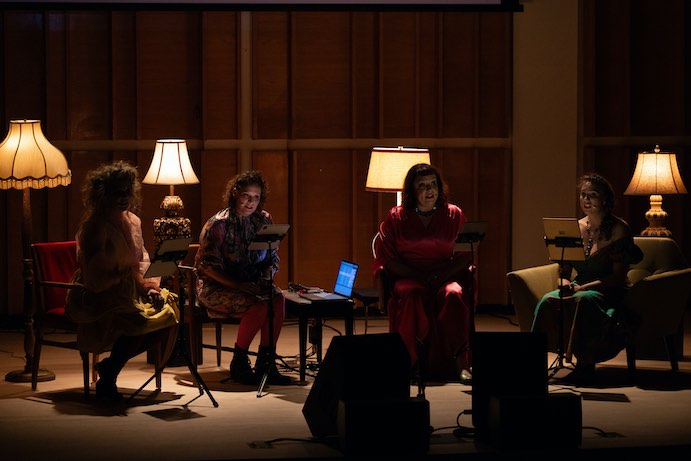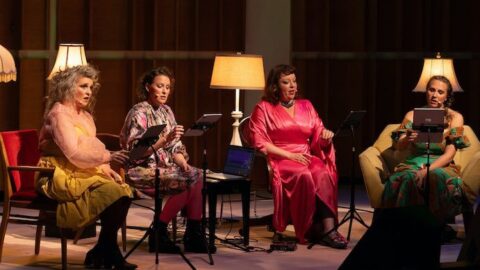Kaufman Music Center inaugurated its new “Artist as Curator” series on Thursday, Oct. 26 with Quince Ensemble. Advertised as “thrilling new collaborations curated by groundbreaking artists,” the series emphasizes the freedom that their guest curators are granted. In the words of John Glover, Kaufman’s director of artistic planning, the members of Quince — Liz Pearse, Kayleigh Butcher, Amanda DeBoer Bartlett, and Carrie Henneman Shaw — were “given the keys to the car,” and the result was a showcase for the work of multi-disciplinary artist Paul Pinto.
Pinto performed a solo excerpt from his recent piece Whiteness (2023). Self-accompanied on piano and in dialogue with texts projected on a screen, Pinto transformed the sea shanty/work song “On Shaller Brown” into a richly layered rumination on the song’s history and his obsession with it. Bringing together these divergent interests is no small feat, but Pinto’s stage presence, at once passionate and disarming, held them firm. His excellent acting skills allowed him to react to the audience and multimedia components in a way that kept the work coherent even at its most dizzying moments. And, while some passages toward the end became tangential, I was left with a fuller appreciation of both the song and the singer’s fixations.

The second half of the concert was Pinto’s The Approach: Part One (2023) — the type of work I hope future “Artist as Curator” concerts will embrace. Written as “a love story for and about the women of Quince,” the magical-realist song cycle was intimate, experimental, and attuned to each performer. And it is also incomplete, which allowed the audience to experience a dazzling and polished performance of something raw and in progress; it offered that rarest of possibilities in new music — genuine surprise.
The best quality of The Approach is the sensitivity that Pinto brings to writing for the group’s individual talents. There are no vocal challenges for Quince, and this work proves it. They effortlessly fired off radiophonic 1960s soul-harmony chants at a tempo marking of 220 Words per Minute (WPM), then instantly changed gears to produce beautiful homophonic bell tones. But the work is sprawling, and there are structural difficulties that prevent it from achieving the cohesion of “On Shaller Brown.” The cast is too large, with six characters, and the drama shifts from narrative to stream of consciousness to possible psychomachia without enough connection. The stage set and projections weren’t integrated enough, especially since the video didn’t begin until a third of the way into the piece and occasionally became a distraction.

But these difficulties wound up becoming assets. After the applause, strangers in the row ahead of me immediately turned and asked for my opinion. Rather than exchanging the usual generic plaudits, we discussed what Pinto should do next. I wanted the piece to go full stream of consciousness; they pushed for a more traditional story. We listened and absorbed each other’s ideas. We disagreed and changed opinions. I am convinced we were not the only ones conversing like this. I hope that both Quince and Kaufman Music Center will continue programming works in-progress because the incompleteness was, in the end, generative.
I CARE IF YOU LISTEN is an editorially-independent program of the American Composers Forum, and is made possible thanks to generous donor and institutional support. Opinions expressed are solely those of the author and may not represent the views of ICIYL or ACF.
You can support the work of ICIYL with a tax-deductible gift to ACF. For more on ACF, visit the “At ACF” section or composersforum.org.
























